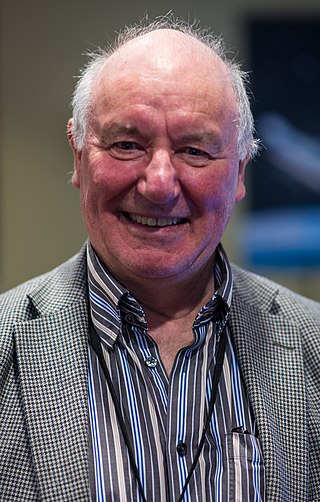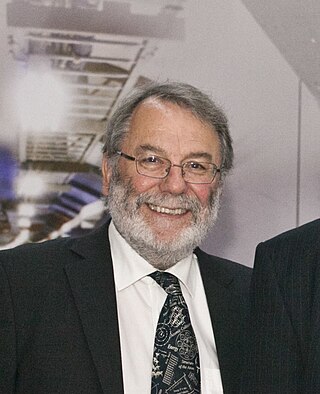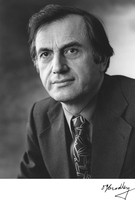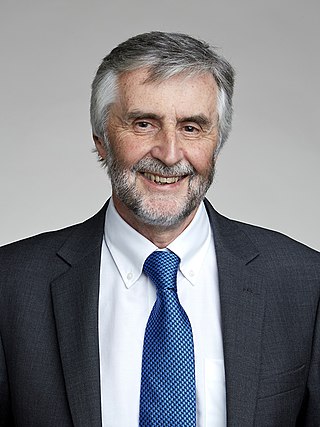Related Research Articles

The Cavendish Laboratory is the Department of Physics at the University of Cambridge, and is part of the School of Physical Sciences. The laboratory was opened in 1874 on the New Museums Site as a laboratory for experimental physics and is named after the British chemist and physicist Henry Cavendish. The laboratory has had a huge influence on research in the disciplines of physics and biology.

The Rumford Medal is an award bestowed by Britain's Royal Society every alternating year for "an outstandingly important recent discovery in the field of thermal or optical properties of matter made by a scientist working in Europe".

Frederick Sydney Dainton, Baron Dainton, Kt, FRS, FRSE was a British academic chemist and university administrator.

Malcolm Sim Longair is a British physicist. From 1991 to 2008 he was the Jacksonian Professor of Natural Philosophy in the Cavendish Laboratory at the University of Cambridge. Since 2016 he has been Editor-in-Chief of the Biographical Memoirs of Fellows of the Royal Society.

Alan Richard Bundy is a professor at the School of Informatics at the University of Edinburgh, known for his contributions to automated reasoning, especially to proof planning, the use of meta-level reasoning to guide proof search.

Sir Peter Leonard Knight is a British physicist, professor of quantum optics and senior research investigator at Imperial College London, and principal of the Kavli Royal Society International Centre. He is a leading academic in the field of quantum optics and is the recipient of several major awards including the Royal Medal from the Royal Society and the Thomas Young Medal and Prize from the Institute of Physics. He is a former president of the Institute of Physics and the Optical Society of America, the first non North American-based person to take the position.
Philip Ivor Dee CBE FRS FRSE was an English nuclear physicist. He was responsible for the development of airborne radar during World War II. The University of Glasgow named the Philip Ivor Dee Memorial Lecture after him.

The Department of Materials Science and Metallurgy (DMSM) is a large research and teaching division of the University of Cambridge. Since 2013 it has been located in West Cambridge, having previously occupied several buildings on the New Museums Site in the centre of Cambridge.

Daniel Joseph Bradley was an Irish physicist, and Emeritus Professor of Optical Electronics, at Trinity College, Dublin.
Colin Edward Webb is a British physicist and former professor at the University of Oxford, specialising in lasers.
Sir John Ivan George Cadogan was a British organic chemist.
Richard Graham Michael Morris,, is a British neuroscientist. He is known for developing the Morris water navigation task, for proposing the concept of synaptic tagging (along with Julietta U. Frey, and for his work on the function of the hippocampus.
Robert Allan Smith CBE FRS PRSE was a British mathematician and physicist.

Miles John Padgett is a Royal Society Research Professor of Optics in the School of Physics and Astronomy at the University of Glasgow. He has held the Kelvin Chair of Natural Philosophy since 2011 and served as Vice Principal for research at Glasgow from 2014 to 2020.
Violet Rosemary Strachan Hutton FInstP FRSE FRAS, known to her peers as Rosemary, was a Scottish geophysicist and pioneer of magnetotellurics. Her research focused on the use of electromagnetic methods to determine the electrical conductivity and structure of the Earth's crust, lithosphere and upper mantle, with a particular focus on the African continent and Scotland. She spent over two decades at the University of Edinburgh School of GeoSciences as a researcher and lecturer and was a Fellow of many societies including the American Geophysical Union and The Royal Society of Edinburgh.
Alan James Duncan FRSE FRSA was a Scottish atomic physicist who created a metastable atomic hydrogen beam apparatus used to first observe the two-photon decay of metastable hydrogen and measure fundamental predictions of quantum theory.

Patrick Gill is a Senior NPL Fellow in Time & Frequency at the National Physical Laboratory (NPL) in the UK.

Sheila Rowan is a Scottish physicist and academic, who is Professor of Physics and Astronomy at the University of Glasgow in Scotland, and director of its Institute for Gravitational Research since 2009. She is known for her work in advancing the detection of gravitation waves. In 2016, Rowan was appointed the (part-time) Chief Scientific Advisor to the Scottish Government.

Donna Theo Strickland is a Canadian optical physicist and pioneer in the field of pulsed lasers. She was awarded the Nobel Prize in Physics in 2018, together with Gérard Mourou, for the practical implementation of chirped pulse amplification. She is a professor at the University of Waterloo in Ontario, Canada.
References
- 1 2 "Professor Wilson Sibbett FRS, CBE". The Royal Society. Retrieved 25 January 2009.
- 1 2 "The Royal Society of Edinburgh | Scotlands chief advisor on science appointed by The RSE". royalsoced.org.uk. Retrieved 16 August 2016.
- ↑ Proceedings of the Royal Society of Edinburgh: obituaries 1999, Alan James Duncan